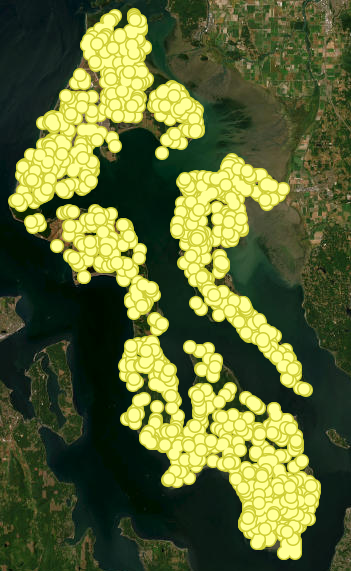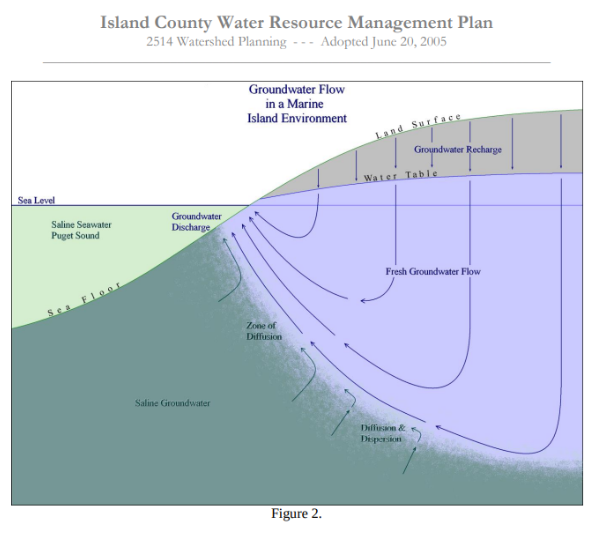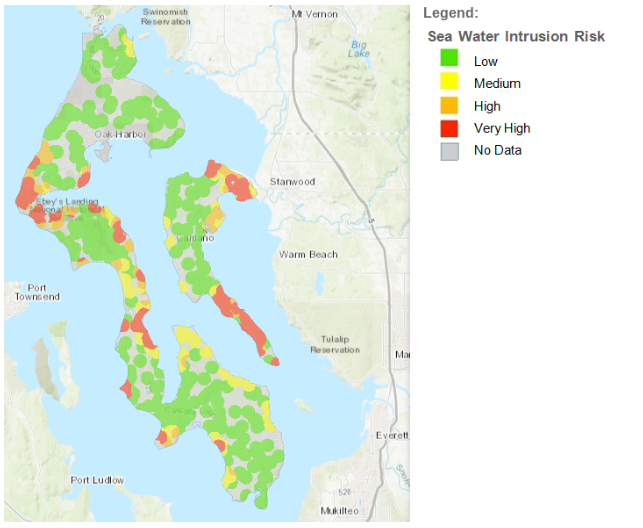Saltwater defines Whidbey Island. We’re surrounded by it. Islands in the ocean are like that. We humans need freshwater, water without the salt. Therefore, keeping saltwater in its place is crucial for survival. Fortunately, Whidbey has freshwater, too. Freshwater flowing into saltwater isn’t usually a problem. The trick is to make sure the flow doesn’t go the other way.
Congratulations if you’re on city water in Oak Harbor
Your water might be coming from off-island. Thanks to Anacortes and the Skagit River, some of Whidbey’s water is piped in from a river that starts in the mountains. Depending on the time of year, you could be drinking recently melted snow. There is not much threat of salt in that water, though there may be minerals, at least at the source.
Look at a map of the island with all its wells marked

The image is carpeted with icons. For an interactive map click here. Barely any land is left to look at. Dots everywhere. That’s OK. Well water is ubiquitous. Many homes get water from community and municipal wells. Living there can feel no different than the piped water in Oak Harbor, it’s just that the pipe doesn’t have to run as far. One indication that something is different is a sign at the neighborhood’s border that announces whether the water supply is Normal or whether there’s rationing. Droughts happen.
Homeowners in more remote places can have an intimate awareness of their water supply because they have a well on their property. Nicer wells get to live in little houses and sheds that are usually far removed from the house, the septic system, and any other buildings. Here’s where there’s a possible mixing of the waters.
Naturally, rainwater falls, and either runs off the land or seeps through it. Rivers and streams are obvious runoff avenues, but sometimes the rainwater is just below the surface. It still flows, but in broad swathes, not as rivers or streams. Water also seeps deeper, flowing into and filling underground aquifers. It is those aquifers that wells drill into.
What are aquifers?
Aquifers are the unseen reservoirs and streams that collect and channel rainwater naturally. That isn’t just an island thing. Farms in the Great Plains drill into massive aquifers. Island aquifers are smaller. They are also a bit of a mystery. What kind of soil are they under and in? How big is it? How deep is it? How much water is in it? Is there more than one?

Hence, the drilling. For decades, residents who want to build on some land have had to check with the County about whether there is already a well, or maybe one they can try to share, or whether they’ll have to hire a well-digger – and hope.
Why all of this prelude and background?
Each aquifer has a limit to how much water can be drawn from it. It may seem obvious in retrospect, but pump out enough fresh water, and the surrounding saltwater can be drawn in, too. Voila or oops, a fresh water supply can run dry, or turning on a tap pours out salty water.
Saltwater coming up a freshwater well was less likely for the early settlers. It could happen if a well was drilled too close to the shore, especially if it was a shallow well. Seawater intrusion is no longer abstract. Look at a map of the island. Click here for an interactive map. A scattering of spots are marked as at risk of seawater intrusion. Some are already experiencing it.

Considerations when purchasing land or a new home
Risk of seawater intrusion can be one reason a neighborhood has to curtail further development. Vacant land can look enticing, but if it can’t access water, then it probably can’t have a livable house built on it. The term ‘water shares’ comes up. So do fees for tapping into restricted supplies. Drilling another well won’t work because it could pull in more of the sea.
Whidbey’s highest point is about 500 feet above sea level. Some wells have drilled so deep that they are hundreds of feet below sea level. And yet, when done right, with the right aquifer, pumped at below a specified rate, there may be no problem. Enjoy your freshwater but, analyzing that map with your broker will help ensure you know where there are concerns and restrictions.
Are there other reasons the water tastes different?
Of course, seawater intrusion is not always the reason water tastes different. Well water is natural. Minerals in the ground are natural. Drinking from an underground aquifer can be flavored by the minerals the water has seeped through. Chefs, cooks, and foodies take note when using natural water and its natural flavorings. It might be an improvement or a reason to buy or get deliveries of filtered water. Some of the minerals and hardness of island water comes from these elements: Arsenic, Calcium, Chloride, Hardness, Iron, Potassium, Magnesium, Manganese, Nitrate, Phosphorus, Sodium, and Sulfate. Household systems can be installed to make the water better match your preferences. Some are as simple as a countertop pitcher with a filter. Others can be systems occupying separate sheds because they’re larger or noisier than an owner wants in the house. Ask your broker who they recommend calling for help.
Are you curious about what’s in your water?
Private and public organizations can test for various chemicals. Your sensitivities will influence your assessment of the water’s quality. Have you ever been encouraged to drink the water as a part of your home inspection? Or even when deciding to write an offer on a property? You should on Whidbey!
The good news is that we know a lot more now than we did before. Within the last few decades, the government has been able to better measure and assess the situation. Guesses are being replaced with answers. Technologies and techniques are being developed that ease the probability of sucking in seawater.
The other good news is that some common sense can make things easier. If the sign says the levels are low, adjust your usage until they recover. It rains here, you know. Trust the rain to water a lawn. Letting your lawn go golden during our dry spells is normal. (Bonus: Less mowing!) Rain catchment systems are gaining acceptance. At the most basic level, use less water. You can benefit, and so can your neighbors.
If you are curious about learning more, or are looking to buy and not currently represented by an agent and would like to work with an agent with extensive knowledge on aquifers and our island connect with us.

 Facebook
Facebook
 X
X
 Pinterest
Pinterest
 Copy Link
Copy Link
